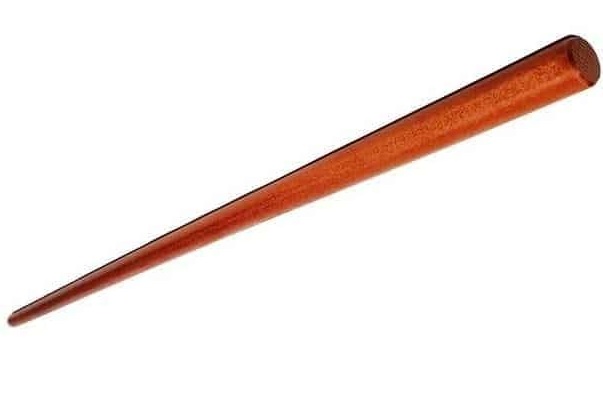Jo Staff: Traditional Martial Arts Weapon
Traditional martial arts are a form of self-defense that utilizes ancient fighting techniques and weaponry. One such weapon that is widely used in traditional martial arts is the Jo Staff. The Jo staff is a simple weapon that has been used for centuries and is still highly respected today. In this article, we will delve into the origins of the Jo Staff, its uses, and techniques. Our goal is to provide comprehensive information about this traditional martial arts weapon to help you better understand its role in martial arts.
Origins of the Jo Staff
The Jo Staff is believed to have originated in Japan during the Edo period (1603-1868). It was originally used as a walking stick by travelers and pilgrims, but over time, it evolved into a weapon used by the samurai. The Jo Staff was highly respected in martial arts circles and was seen as an essential tool for any martial artist.
The Jo Staff, also known as the “Jo,” is a traditional Japanese weapon that has been used for centuries. It is a wooden staff that is approximately four feet long and is often used in martial arts such as Aikido, Judo, and Kendo. In this article, we will delve deep into the history of the Jo Staff, its significance, and how it has evolved over the years.
History of the Jo Staff
The Jo Staff has a long and rich history dating back to feudal Japan. It was originally used by the Samurai as a walking stick, which was later transformed into a weapon. The Jo Staff was primarily used to defend against sword attacks and to disarm opponents.
As time went on, the Jo Staff became an essential tool in martial arts such as Aikido, Judo, and Kendo. Its use spread across the world as these martial arts gained popularity.
Significance of the Jo Staff
The Jo Staff has significant importance in Japanese culture and martial arts. It represents the Samurai spirit and is a symbol of discipline, respect, and honor. In Japanese martial arts, the Jo Staff is often used as a training tool to develop balance, coordination, and concentration.
The Jo Staff is also used in weapons training, where practitioners learn how to use the staff to disarm and defend against sword attacks. It is a versatile weapon that can be used for both offensive and defensive purposes.
Evolution of the Jo Staff
Over the years, the Jo Staff has evolved in terms of its design and usage. Traditionally, the Jo Staff was made of wood, but modern versions are often made of aluminum or graphite.
The length and diameter of the Jo Staff have also changed over time. Initially, the staff was around four feet long, but today, there are shorter and longer versions available.
The techniques used to wield the Jo Staff have also evolved, with different martial arts developing their unique styles. For instance, in Aikido, the Jo Staff is used to deflect and redirect attacks, while in Kendo, it is used for strikes and thrusts.
The Jo Staff has a rich history that spans centuries, and its significance in Japanese culture and martial arts cannot be overstated. It has evolved over time, with new materials, designs, and techniques being developed.
The Jo Staff remains a vital tool in modern martial arts and is used by practitioners worldwide. Whether you are a beginner or an experienced martial artist, the Jo Staff is a valuable weapon to have in your arsenal.
Construction
The Jo Staff is a traditional Japanese weapon that has been used for centuries, primarily in martial arts such as Aikido, Judo, and Kendo. In this section, we will explore the construction of the Jo Staff, the materials used, and the techniques employed to make this wooden weapon.
Materials Used for the Jo Staff
Traditionally, the Jo Staff is made of wood, typically Japanese white oak, which is renowned for its durability and strength. Other types of wood, such as hickory and red oak, are also used. The wood for the staff is selected carefully, taking into account factors such as density, straightness, and uniformity.
The length and diameter of the Jo Staff can vary, but they are typically around four feet long, with a diameter of approximately one inch. The staff is designed to be lightweight and easy to handle, while also being strong enough to withstand impact.
Construction of the Jo Staff
The process of constructing a Jo Staff involves several steps, including selecting the wood, cutting and shaping it, and sanding and finishing the staff.
The first step is to select the wood, which should be straight and free of knots or defects. Once the wood is selected, it is cut to the desired length and shape using a saw or lathe.
The next step is to shape the Jo Staff. This is done by using a variety of tools, such as chisels, rasps, and planes, to create a smooth and uniform surface. The staff is shaped into a tapered cylinder, with one end being slightly thicker than the other.
Once the Jo Staff is shaped, it is sanded to create a smooth and even surface. Sandpaper of various grits is used, starting with coarse grit and progressing to finer grits. The sanding process ensures that the staff is free of any rough spots or imperfections.
The final step is to finish the Jo Staff. Traditionally, the staff is finished with a mixture of beeswax and oil, which helps to protect the wood and give it a glossy finish. Other types of finishes, such as varnish or lacquer, may also be used.
The Jo Staff is a traditional Japanese weapon that has been used for centuries. It is made from carefully selected wood and is constructed using a variety of tools and techniques. The resulting weapon is lightweight, durable, and easy to handle, making it an essential tool for martial artists worldwide.
Uses of the Jo Staff
The Jo Staff is a versatile weapon that can be used for both defensive and offensive purposes. It is typically made of hardwood and can vary in length from 4 to 6 feet. The Jo Staff is used to strike, block, and disarm opponents in martial arts combat.
In addition to combat, the Jo Staff is also used for solo training and kata practice. Kata is a series of movements and techniques performed in a specific order. Practicing kata with the Jo Staff helps martial artists improve their balance, coordination, and technique.
Techniques for Using the Jo Staff
The Jo Staff is a weapon that requires skill and practice to use effectively. There are several techniques that martial artists use when wielding the Jo Staff. These include:
- Basic strikes: The most fundamental technique when using the Jo Staff is basic strikes. These include downward, upward, and diagonal strikes.
- Blocks: The Jo Staff is also used for blocking strikes from an opponent. Blocks can be executed in various directions, including upward, downward, and sideways.
- Disarming techniques: A skilled martial artist can disarm an opponent by using the Jo Staff to catch and pull the weapon away from them.
- Kata practice: As mentioned earlier, kata practice is an essential component of training with the Jo Staff. Kata helps martial artists improve their technique and prepares them for real-world combat situations.
Jo Staff vs Bo Staff vs Han Bo Staff
The Bo staff, Jo staff, and Han Bo staff are traditional martial arts weapons that vary primarily in length and thus serve different purposes in training and combat.
Bo
- The Bo staff is a long martial arts weapon, traditionally measuring around 6 feet in length.
- It’s designed for reach and leverage, allowing practitioners to maintain a safe distance from opponents while executing various strikes, blocks, and sweeps.
- The Bo staff’s length makes it particularly effective in engaging multiple attackers or in situations where additional reach can provide a strategic advantage.
- Typically used in martial arts such as Kobudo and some styles of Karate, the Bo staff demands a significant amount of space to maneuver effectively.
Jo
- At a shorter length of approximately 4 feet, the Jo staff is a more versatile weapon in terms of manageability and agility.
- Its size enables more fluid and rapid movements, which can be advantageous in close-quarter combat scenarios.
- Practitioners can employ both ends of the Jo staff for striking and defensive techniques, with the shorter length allowing for quicker transitions between actions.
- The Jo staff is commonly used in Aikido and Jodo, and its dimensions are well-suited to indoor practice as well as outdoor training.
Han Bo
- The Han Bo staff is essentially a half-length Bo staff, usually about 3 feet long, hence its name “Hanbo” which translates to “half staff” in Japanese.
- Due to its compact size, the Han Bo staff provides excellent control and is easy to carry, making it a practical choice for self-defense.
- It is often used to apply joint locks and pressure point strikes due to its length, which closely resembles that of other everyday items such as walking sticks or batons.
- The Han Bo staff is excellent for practicing precision and technique, serving as a bridge between unarmed combat and longer staff weaponry.
Each type of staff offers distinct advantages depending on the practitioner’s skill level, martial arts style, and specific training goals. The Bo staff is known for its reach and power, the Jo staff for its versatility and speed, and the Han Bo staff for its precision and ease of use in tight spaces. Understanding the unique qualities of each weapon can enrich a martial artist’s practice and enhance their overall combat proficiency.
Final Thoughts
In conclusion, the Jo Staff is a traditional martial arts weapon that has been used for centuries. Its origins can be traced back to Japan during the Edo period. The Jo Staff is a versatile weapon that can be used for both defensive and offensive purposes, as well as for solo training and kata practice. Techniques for using the Jo Staff include basic strikes, blocks, disarming techniques, and kata practice.
We hope this article has provided you with comprehensive information about the Jo Staff and its role in traditional martial arts. Remember, the Jo Staff is a weapon that requires skill and practice to use effectively. With dedication and hard work, anyone can learn to wield the Jo Staff with precision and skill.
Passionate About Learning More?
We hope you appreciated this article. For more information on traditional martial arts weaponry, we suggest reading the subsequent articles.
Next Martial Arts Weapons article: Jutte (Jitte) Japanese Martial Arts Weapon
Previous Martial Arts Weapons article: Jiu Jie Bian (or Chinese Chain Whip) Chinese Martial Arts Weapon
Step into the realm of Martial Arts Weapons with this in-depth article located here at Dojo Directory.


